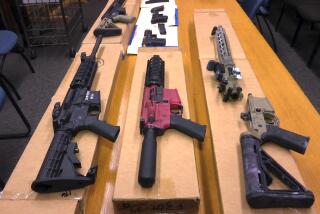U.S. appeals court expresses concern about sting operations that overwhelmingly target blacks and Latinos

- Share via
A federal appeals court made it easier Monday for people snagged in “reverse sting” operations to seek evidence that the government targeted blacks and Latinos.
The 2-1 decision by the U.S. 9th Circuit Court of Appeals portrayed a troubling effort by federal law enforcement to lure blacks and Latinos to participate in purported robberies of fictitious stash houses.
“There is no legitimate dispute that these stings primarily affect people of color, but the government has steadfastly resisted any defense attempt to determine whether enforcement is racially biased,” Judge Jacqueline H. Nguyen wrote in a concurrence. Nguyen also wrote the majority decision.
The case was brought by Daryle Lamont Sellers, an African American man who was convicted of conspiracy to distribute cocaine and conspiracy to interfere with commerce by robbery as a result of 2012 stash house reverse sting.
Sellers argued that he was targeted based on his race and presented evidence that the overwhelming majority of the defendants targeted by law enforcement in similar investigations are African Americans or Latinos.
To prevail, Sellers must show that the operation not only resulted in discrimination but that it also was motivated by bias.
A district judge denied Sellers’ discovery motion for government evidence. The 9th Circuit overturned that decision, saying it was based on bad law, and told the lower court to reconsider.
The 9th Circuit traced the evolution of the reverse stings to Miami in the early 1990s. The Bureau of Alcohol, Tobacco and Firearms decided to stage them in response to drug cartels moving huge amounts of cocaine through South Florida.
That movement “attracted freelance criminals who tried to poach the shipments, often resulting in shootouts or attacks on innocent people,” wrote Nguyen, an Obama appointee.
Eventually, the reverse stings spread to at least 22 states, including California.
Typically in the stings, the amount of cocaine that targets are told will be stolen exceeds 5 kilograms, an amount that triggers a 10-year minimum sentence, Nguyen said.
Targets also are encouraged to bring guns, zip ties or duct tape, evidence that shows intent to participate in a conspiracy and also allows for the charging of additional crimes, Monday’s decision said.
In the operation that netted Sellers and dozens of others, the ATF set up the reverse sting near downtown Los Angeles.
An undercover agent posing as a disgruntled drug courier recruited others to help rob a house where his purported employer was stashing lots of drugs. In fact, there was no stash house or drugs.
The agent who ran the operation later testified that more than 55 of the approximately 60 indicted in his stash house operation were racial minorities.
Nguyen said courts should recognize that the choice of locations for these operations, usually in neighborhoods with large black and Latino populations, may be evidence of discrimination.
She said the government typically allows an informant to decide whom to target, “introducing a host of biases and bad incentives into the process.”
Sellers was sentenced to 96 months in prison.
“Not surprisingly,” Nguyen wrote, “ given the way in which they are selected, targets of stash house stings and their co-conspirators sometimes have modest criminal résumés.” She said that 90% of those convicted nationwide in stash house stings have been black and Latino.
“Law enforcement agents — whether consciously or not — appear to primarily target racial minorities,” she wrote.
Carl Gunn, who represented Sellers before the 9th Circuit, said the defense community has long railed about these operations
“These are horrible cases,” Gunn said. “They dangle tens of thousands of dollars in cocaine in front of people with virtually no money.”
He said Sellers had never been involved in a stash house robbery when he was recruited.
The federal prosecutor who argued the case before the 9th Circuit referred questions to a press officer, who declined comment.
Judge Susan P. Graber dissented, contending the district court relied on correct legal principles when denying the discovery request.
She said the evidence offered by Sellers was insufficient to raise an inference of discrimination.
ATF agents testified that they pursued violent offenders with experience in the drug trade, wrote Graber, a Clinton appointee. Sellers, she said, was recruited into the conspiracy by a co-conspirator.
Twitter: @mauradolan
More to Read
Sign up for Essential California
The most important California stories and recommendations in your inbox every morning.
You may occasionally receive promotional content from the Los Angeles Times.














